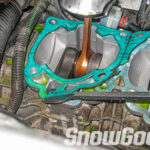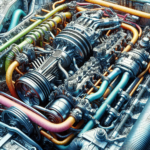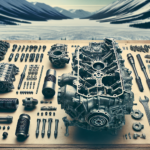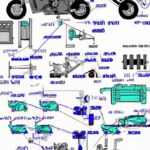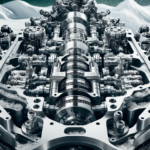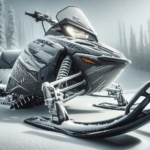In the realm of snowmobile maintenance, ensuring a clean carburetor is crucial to optimal performance. This article will guide you through the essential steps of cleaning your snowmobile’s carburetor, a regular maintenance task that can significantly extend the life and efficiency of your machine. So whether you’re a professional mechanic or a do-it-yourself enthusiast, this article has the knowledge you need to keep your snowmobile running smoothly all winter long.
Understanding the Function of a Carburetor
A carburetor is a critical part of a snowmobile or any other internal combustion engine. Its primary role is that of a conduit, mixing air and fuel in appropriate proportions to facilitate effective combustion. To achieve this, the carburetor operates through a simple mechanism of air vacuum creation that draws in fuel, leading to the creation of a combustible air-fuel mixture.
The Role of a Carburetor in a Snowmobile
In a snowmobile, the carburetor plays an even more significant function. Given the frigid conditions in which snowmobiles operate, the carburetor must be finely tuned to ensure the right mix of oxygen and fuel to keep your snowmobile running efficiently. Any glitch in its functioning directly impacts your vehicle’s power, fuel efficiency, and overall performance.
Understanding the Parts of a Carburetor and Their Functions
Getting to know your carburetor involves understanding its primary components and their roles. Broadly, the carburetor consists of the throttle plate that manages airflow, the venturi, a tube developing a vacuum, and the jet that controls the amount of fuel entering the air stream. The float chamber stores fuel ready for use, while the choke controls air intake during cold starts. All these components work in harmony to deliver the right air-fuel mix for optimum combustion.
Knowing When to Start Cleaning
Like any mechanical device, the carburetor’s performance can decline over time due to dust, fuel residue build-up or wear and tear of its components. Knowing when to clean becomes a crucial aspect of maintenance.
Signs of a Faulty Carburetor
Some tell-tale signs may indicate a dirty or damaged carburetor. These include difficult cold starts, inconstant idling, increased fuel consumption, frequent stalling, or decreased power during operation. Any or all of these signs may suggest the need for a carburetor cleanup or repair.
Effects of Neglecting Signs of a Dirty Carburetor
Ignoring these signs can lead to more severe problems. A dirty carburetor not only reduces your snowmobile’s performance but can also lead to damage to other engine components. Therefore, it’s crucial to handle any carburetor issues promptly.
Picking the Right Moment to Start Cleaning
The best time to clean your carburetor is preemptively, as part of your regular vehicle maintenance. However, if you’re observing any of the above-listed issues, you might want to expedite that process.
Preparing for the Cleaning Process
Before you start cleaning, make sure you are well-prepared for the task.
Assembling the Necessary Tools and Materials
You’ll need various tools such as wrenches, screwdrivers, pliers, and a wire brush. Also, carburetor cleaner, a cleaning tray, compressed air can, and gloves to protect your hands.
Ensuring Safety Before Starting the Process
Safety is paramount in any mechanical work. Ensure you are working in a well-ventilated area, away from any flames or sparks considering that you’re dealing with flammable substances. Also, don safety glasses and gloves to protect yourself from cleaning agents.
Pre-Cleaning Checks to Rule Out Other Issues
Before you start to dismantle your carburetor, it’s a good idea to rule out other issues that might be causing a problem. Checking elements like spark plugs, fuel filters, fuel lines, and air filters can save you unnecessary carburetor cleaning.
Removing the Carburetor
Now, you’re ready to remove the carburetor.
Step-by-Step Guide to Safely Disconnecting and Removing the Carburetor
Firstly, disconnect the fuel line and drain the fuel from the carburetor into a container. Next, disconnect the throttle cable. Lastly, remove the bolts that secure the carburetor to the engine manifold, and the air intake tube on the other end.
Avoiding Common Mistakes During the Removal Process
While removing the carburetor, avoid forcing parts apart or losing small bits. Take photos or make sketches during disassembly. This helps during reassembly by acting as a guide, ensuring you’ve put everything back in its place.
Disassembling the Carburetor
Once removed, you need to disassemble the carburetor for cleaning.
Guiding Through the Disassembly for Cleaning
Follow the carburetor’s specific schematic (often available in the service manual) during disassembly. Remove the throttle plate, followed by the float chamber and jet.
Keeping Track of the Parts During Disassembly
As you disassemble, remember to keep all parts in order as they can be similar in appearance but serve different functions.
Identifying Parts Too Damaged for Cleaning
Parts that show signs of wear and tear, or have visible damage, are better replaced than cleaned. If neglected, these components can undermine the overall performance of your carburetor.
Cleaning the Carburetor Components
Now, to the actual cleaning process.
Choosing the Right Cleaning Agent and Technique
A good carburetor cleaner is critical. It dislodges gummy deposits, carbon build-up and other impurities. Use a wire brush or compressed air to clean stubborn residue.
Detailed Cleaning Procedure for Each Component
Make sure to spray the cleaner into all the orifices, tubes and jets, then clean with a wire brush or compressed air. Avoid using sharp objects that could possibly change the shape of the orifices leading to poor functionality.
Commonly Overlooked Parts That Also Require Cleaning
Small components like jets, tubes, and air passages are often overlooked. These parts are essential to the air-fuel mixture aspect of the carburetor’s function and must be cleaned thoroughly.
Inspecting and Replacing Damaged Parts
Once cleaned, you need to inspect all parts.
How to Inspect Carburetor Components for Wear or Damage
Look for signs of damage like scratches, wear, or residue that couldn’t be cleaned. If in doubt, replace.
Finding the Right Replacement Parts
Stick to recommended parts to match your specific carburetor make and model. This helps to maintain the carburetor’s efficiency and longevity.
Replacing the Damaged Parts
Follow your schematic and replace the parts that are worn out or damaged. Remember latter equals poorer performance.
Reassembling the Carburetor
Once clean and with damaged parts replaced, reassemble.
Step-by-Step Guide on Effectively Reassembling the Carburetor
Using your sketches or photos, rebuild the carburetor starting with the jet, followed by the float chamber, and then the throttle plate.
Double-Checking Your Work for Common Errors
Go through your work more than once to make sure you haven’t missed anything and everything is back to where it should be.
Reinstalling the Carburetor
Now it’s time to reinstall your carburetor back into your snowmobile.
Proper Installation Procedure for the Carburetor
Reattach the carburetor to the engine manifold, followed by the air intake tube. Reconnect the throttle cables and then the fuel line. Tighten all bolts firmly yet cautiously to avoid cracking the carburetor housing.
Ensuring All Connections are Secure and Functioning
Double-check all connections to make sure they’re secure. Start your snowmobile and let it idle to check for any abnormalities.
Maintaining a Clean Carburetor
With the hard part done, maintaining the cleanliness of your carburetor becomes a lot easier.
Routine Maintenance Tips
Part of keeping the carburetor clean involves using clean, pure fuel, replacing fuel filters regularly, and using a fuel stabilizer during long periods of disuse.
Keeping the Carburetor Clean for Longer
Conduct a routine check-up and clean-up every riding season or according to the manufacturer’s recommendation to keep the carburetor in top shape.
Understanding Common Issues and How to Avoid Them
Knowledge is your best defense against common carburetor problems. Understanding the function and common issues of each part will help detect a problem early on and avoid it from escalating to severe damage.
That’s all about cleaning the carburetor on your snowmobile. Remember, regular maintenance and cleaning not only prevents issues but also ensures optimum performance of your snowmobile. Now, put on your helmet, suit up and ride out into the snow, confident in the knowledge that your carburetor is squeaky clean and functioning perfectly. Happy riding!
- What Snowboard Bindings Should I Get? - January 23, 2024
- What Size Screws For Snowboard Bindings? - January 23, 2024
- How To Snowmobile On Water? - January 23, 2024

